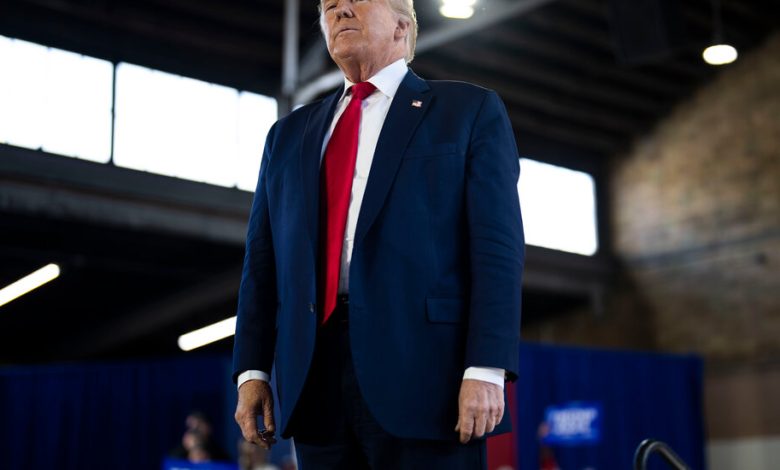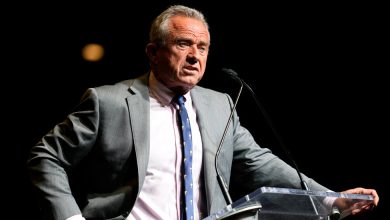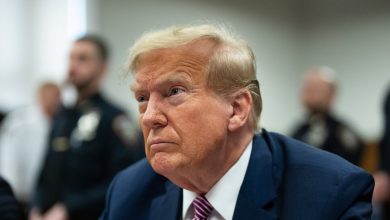Trump’s Giant Lead Is Financial, Too: 6 Takeaways From 2024 Filings

Donald J. Trump’s presidential campaign entered October with nearly as much cash on handfor the Republican primary race as the rest of the field combined, underscoring the former president’s dominance as the contest enters its critical final stretch before the Iowa caucuses in January.
The financial picture, laid out in quarterly fund-raising and spending reports filed by campaigns on Sunday, shows just how uphill Mr. Trump’s challengers are fighting, with some of them appearing to hemorrhage cash. Still, others showed signs of momentum.
Cash on hand is a vital measure of a campaign’s health at this point in the race, because the next three months will be expensive. The candidates need to make an impression in the first states where voters will have their say: Iowa, New Hampshire, Nevada and South Carolina. For many, that means more travel, ads and events.
Among the starkest revelations of the filings on Sunday was the state of Gov. Ron DeSantis’s campaign, which spent almost every dollar it raised in the third quarter. Even after he pared back his campaign staff and made an aggressive fund-raising push, his campaign entered October with unpaid bills, and with cash on hand that was barely above that of former Gov. Chris Christie of New Jersey.
There were also warning signs for former Vice President Mike Pence, whose campaign appeared to be running perilously low on cash, and for Senator Tim Scott of South Carolina, whose campaign spent more than twice what it took in, eating into the large war chest he had at the outset of his campaign.
The filings offer only a partial view of 2024 candidates’ finances. Super PACs, which can raise and spend unlimited amounts, do not have to release their next reports until Jan. 31. Similarly, joint fund-raising committees, which several of the candidates use as their main fund-raising platforms, did not have to file on Sunday.
Here are six takeaways on what the filings say about next year’s elections for president and Senate.
Trump has a clear edge — but its full scope is unclear.
Mr. Trump’s campaign committee reported receiving $24.5 million in the third quarter, which includes July, August and September. The vast majority of that cash was transferred from a joint fund-raising committee through which he primarily raises money.
The joint fund-raising committee, Save America, was not required to file a quarterly report on Sunday, which means that detailed donor information was not readily available. The Trump campaign has said he raised $45.5 million total in the third quarter.
According to the fine print on Save America’s website, 10 percent of every contribution is routed to Mr. Trump’s super PAC, MAGA Inc., an entity that has in the past paid his legal bills.
The filing reported $37.5 million in cash on hand, of which the campaign said $36 million could be spent on the primaries.
DeSantis and Scott have been big spenders.
On the surface, Mr. DeSantis, the Florida governor, appeared to have a decent quarter, raising $15 million between his campaign and a new joint fund-raising committee, which filed an October report alongside the campaign.
But his campaign reported only $5 million in cash on hand for the primaries, and listed more than $1 million in debt, which the filings show are outstanding bills.
His campaign spent more than $11 million in the quarter, the filings showed, with significant sums spent on travel and transportation: At least $500,000 went to private aviation companies, and $723,000 went to a limited liability company that his campaign has used to pay for his travel before.
The campaign of Mr. Scott, who entered the third quarter with more than $21 million in cash on hand — he had moved about $22 million from a Senate campaign fund when he entered the presidential race this year — reported raising $4.6 million.
His campaign entered October with $11.6 million in cash on hand for the primary, and reported spending $12.4 million in the quarter, including $1.2 million on travel and at least $2.5 million marked for online advertising. (As in the previous quarter, the vast majority of his spending was directed through two limited liability companies that made the funds’ ultimate destination difficult to trace.)
Haley and Christie padded their war chests for the fights ahead.
Some of the candidates — notably Nikki Haley, the former United Nations ambassador, and Mr. Christie — appeared to have gained fund-raising momentum over the past three months, and have increased their cash on hand by raising funds and running lean campaign operations.
Mr. Christie raised $3.8 million in the third quarter, more than double his haul from the second quarter, possibly reflecting a boost from the two debates. His campaign increased its total cash on hand from $1.5 million to $3.9 million, nearly all of which is for use in the primaries.
Ms. Haley’s campaign has said she raised $11 million across the political committees she controls — including from more than 40,000 new donors. Her campaign’s filing on Sunday showed that the campaign committee itself raised $8.24 million, including $1.7 million transferred from one of her other committees. The campaign spent $3.5 million in the quarter, and entered October with $9.1 million that can be spent on the primary.
Mike Pence may be in trouble.
Mr. Pence’s campaign reported having only $1.2 million in cash on hand at the end of the third quarter, a strikingly small figure that includes money the campaign cannot touch in the primary.
Mr. Pence’s campaign also reported $620,000 in debts.
The former vice president reported raising $3.3 million in the third quarter — an improvement over the second quarter, when he took in $1.2 million, and most likely a reflection of his strong performance in the first debate.
But his campaign also spent nearly $3.3 million in the most recent quarter.
Biden remains on solid footing, and his small-donor enthusiasm rose.
President Biden’s re-election campaign continues to be the best-funded apparatus in politics, raising far more than any of his would-be Republican challengers.
While all expectations are that presidential campaigns raise less in the third quarter of the year before an election — filled with summer holidays that are often a big-money dead zone — than they do in the second, Mr. Biden raised nearly as much ($71.3 million) among his three fund-raising vehicles as he did in the second quarter ($72 million).
The Biden campaign will be pleased with its performance among donors who gave less than $200. Those donors — who gave $15 million in the third quarter, an increase from $10 million in the previous reporting period — are important both because they serve as a key barometer of excitement and because campaigns can go back to them again and again to ask for more money.
Just as Mr. Biden’s aides and allies insist his lowly poll numbers will improve once voters recognize that the general election will be a choice between him and Mr. Trump, there is an expectation within the campaign that the online money spigot will be turbocharged to defeat Mr. Trump just as it was once Mr. Biden became the Democratic nominee in 2020. (It remains behind Mr. Trump’s pace at this point in the 2020 campaign.)
Mr. Biden and his campaign have recently begun a deliberate shift — made in the final days before the end of the third fund-raising quarter, which was no coincidence — to frame the campaign as a contest between the current and former president.
On the Senate front, Democrats hold a financial advantage.
Democrats have an unfriendly Senate map in 2024, playing defense in several red states.
But in many of the Senate battlegrounds, Democrats appear to maintain a financial advantage — in large part thanks to the power of incumbency.
Democratic senators hold seven of the eight seats in the chamber that both parties view as the most competitive this year, although Senator Debbie Stabenow of Michigan has said she is not seeking re-election and Senator Joe Manchin III of West Virginia hasn’t announced his plans.
The one battleground seat not held by a Democrat is in Arizona, which is represented by Senator Kyrsten Sinema, an independent who dropped her Democratic affiliation last year. Ms. Sinema, who hasn’t announced yet whether she will run for re-election, has $10.7 million in the bank after raising $375,000 last quarter.
That fund-raising total was less than half of what she raised in the previous quarter and a fraction of the $2.9 million collected in the third quarter of the year by Representative Ruben Gallego, the top Democrat in the race. Mr. Gallego has raised $10.7 million since opening his campaign this year and has already spent much of that total, leaving him with about $5 million in the bank.
On the Republican side, Mark Lamb, the sheriff of Pinal County, Arizona, raised about half a million dollars, and spent roughly as much. He has just over $300,000 on hand. Kari Lake, who lost her race for governor of Arizona last year, opened her Senate campaign this month.
In Ohio, Senator Sherrod Brown has been one of the Democratic Party’s most prodigious fund-raisers this year. His campaign took in $5.8 million in the last quarter, including transfers from other committees he controls, and now has $11.2 million in cash on hand.
Senator Tammy Baldwin of Wisconsin, a Democrat seeking her third term, raised $3.1 million for her campaign, and entered October with $6.9 million.
Senator Jacky Rosen, a Nevada Democrat, raised $2.1 million and has $8.8 million in the bank. Her closest Republican challenger, Sam Brown, a retired Army captain, collected $1.1 million and has about $938,000 on hand.



